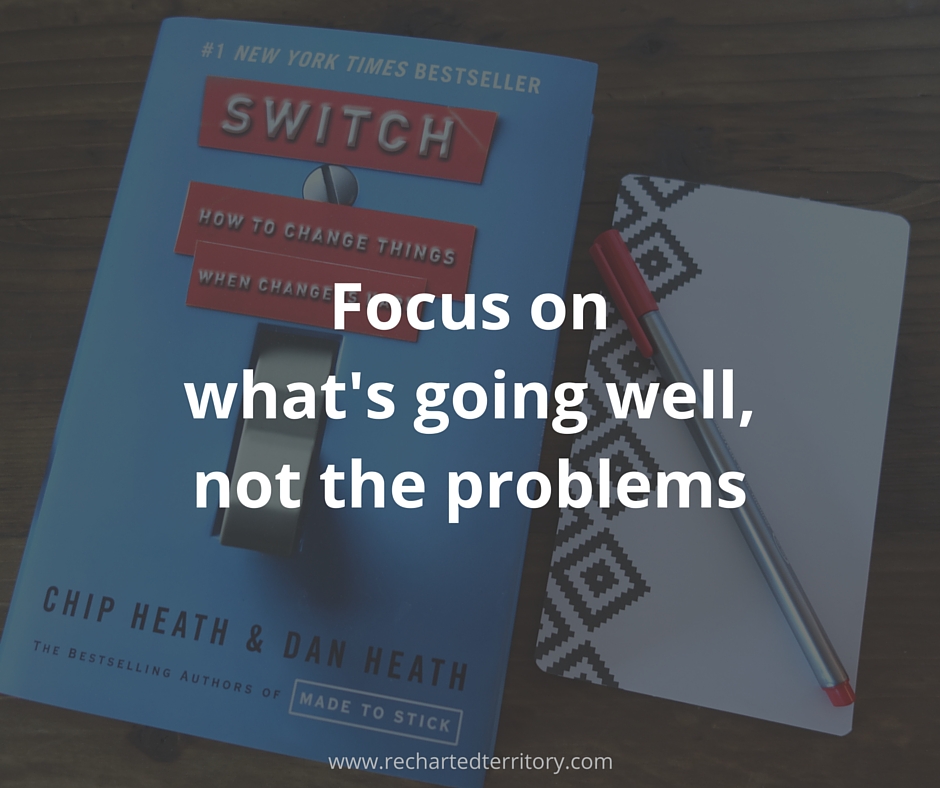

DC got hit by #Snowzilla last weekend so there was plenty of time to catch up on some reading, especially the January pick on the Recharted Territory Reading List, “Switch” by Chip and Dan Heath.
The book was all about how to “change things when change is hard.” In the table of contents, the authors outline the overall strategies:
- Direct the Rider
- Find the bright spots
- Script the critical moves
- Point to the destination
- Motivate the Elephant
- Find the feeling
- Shrink the change
- Grow your people
- Shape the path
- Tweak the environment
- Build habits
- Rally the herd
Note: If you haven’t read the book and don’t know the lingo, the Rider and Elephant analogy originated in Jonathan Haidt’s book “The Happiness Hypothesis.” The Rider represents our rational side and the Elephant represents our emotional side.
We’ve covered a couple of the topics explored in the book in past posts, like creating a vision to “point to the destination”, making adjustments to your environment, and building new habits. We also talked about a way to “shrink the change” by creating roadmaps to show a path to the vision.
There were a lot of great new tips from this book but one in particular that I want to dive into today:
[clickToTweet tweet=”‘Focus on what’s going well, not the problems'” quote=”‘Focus on what’s going well, not the problems'”]
Maybe it’s because the DC area just got hit with a giant blizzard (I think people are still shoveling snow in some parts) but the hopeful message came at the perfect time.
What’s also great about this tip is that it’s relatively easy to execute. All you need to do is observe existing behavior around you and reframe your thinking to recognize and support the progress that’s already been made towards a goal.
Let’s talk a little more about why this is effective before jumping into ways to apply this to your life.
Focus on what’s going well
When the authors talked about how some people use the “burning platform” metaphor to evoke a sense of crisis to encourage change, that resonated with me. I always heard that people wouldn’t change unless they were forced to. Until they felt enough pain.
Chip and Dan say that negative emotions could be motivating if you know how to respond to the challenge, but they won’t be as effective if the change in behavior requires more creative thinking to determine the next action. Examining the Rider side of us reveals why,
In tough times, the Rider sees problems everywhere, and “analysis paralysis” often kicks in. The Rider will spin his wheels indefinitely unless he’s given clear direction. That’s why to make progress on a change, you need ways to direct the Rider. Show him where to go, how to act, what destination to pursue.
– Chip and Dan Heath
The Heath brothers suggest that instead of spending all of your time worrying about problems, you should look for the “bright spots” where things are already going well.
To pursue bright spots is to ask the question “What’s working, and how can we do more of it?”
-Chip and Dan Heath
They also explain why bright spots are so important to break free of inertia and direct the Rider.
…if you’re trying to change things, there are going to be bright spots in your field of view, and if you learn to recognize them and understand them, you will solve one of the fundamental mysteries of change. What, exactly, needs to be done differently?
– Chip and Dan Heath
In my own experience, an extended focus on problems in a difficult and complex system can also feel like a game of “whack-a-mole.” The “fight” can fuel you for a while but over time, it’s a drain on morale and hope. In contrast, I’ve also seen how supporting and growing the successful areas energizes people and encourages teamwork instead of scapegoating.
Chip and Dan urge managers to look at the ratio of time we’re spending solving problems vs. scaling success. This reminds me of building a fire. If you have a spark, do you spend your energy focusing on everywhere that is still dark? On lighting more matches? Or are you fanning and growing the part that is already burning?
Let’s jump into ways to identify and scale “bright spots.”
Some ways to identify bright spots
General approach
- Define what success looks like. You might find that success is not an absolute number but a relative value in comparison to the average. Identifying what you’re searching for is the first step to finding it. Example: the Heath brothers share a story of Jerry Sternin, who was working with Save the Children in 1990 when he was assigned to help fight malnutrition in Vietnam. He decided to look for children who were bigger and healthier than the typical child.
- Make sure you understand what the normal behavior is so you can recognize any “bright spot” deviations. Example: Sternin and the local mothers talked to other people in the community so they could understand which behaviors were normal, and what the families of healthier children were doing differently.
- Look for characteristics that other people can replicate. Example: Sternin recognized that not everyone would have a rich uncle to support them. Yet all mothers could change how often they fed their kids and what they fed them.
Ways to collect information
- Talk to people. Ask them about their daily lives, especially how they spend their time.
- Observe people. Sometimes people don’t realize that they’re doing anything different, so they won’t mention it during a conversation.
- Ask people to nominate others. You can’t be everywhere at once so encourage your team to nominate others who are excelling.
- Ask people to share their wins. Give them a forum to share what is going well, instead of focusing every conversation on what’s broken.
Ways to scale bright spots
- Help people practice the new behavior. Rather than Sternin lecturing about the need to change how they fed their children, the community started cooking groups where mothers would cook healthier food together. When people changed their actions it was easier to keep the momentum.
- Get support from influential players in the community. We talked a little about this in the post about habits, but your social ties can play a very important role in either scaling or blocking change. In the case of the cooking groups, social peer pressure helped keep them going.
- Be aware of how you frame your message. Sternin’s approach was effective and sustainable because he highlighted what the community was already doing vs. what he as an outsider thought that they should be doing. “Imported” solutions aren’t always adopted as well as homegrown ones.
- Make it public. Make sure other people are aware of the bright spot behavior and that you consider it a bright spot in your change journey. According to the Heath brothers, sharing techniques that work not only appeals to the Rider’s need for clarity, but also the Elephant’s need for hope.

Related reading
The authors have a great website with some workbooks and podcasts to complement your efforts. I definitely recommend that you check them out and see if they help you in your endeavors.
What other insights did you draw from this book? How will you apply them?